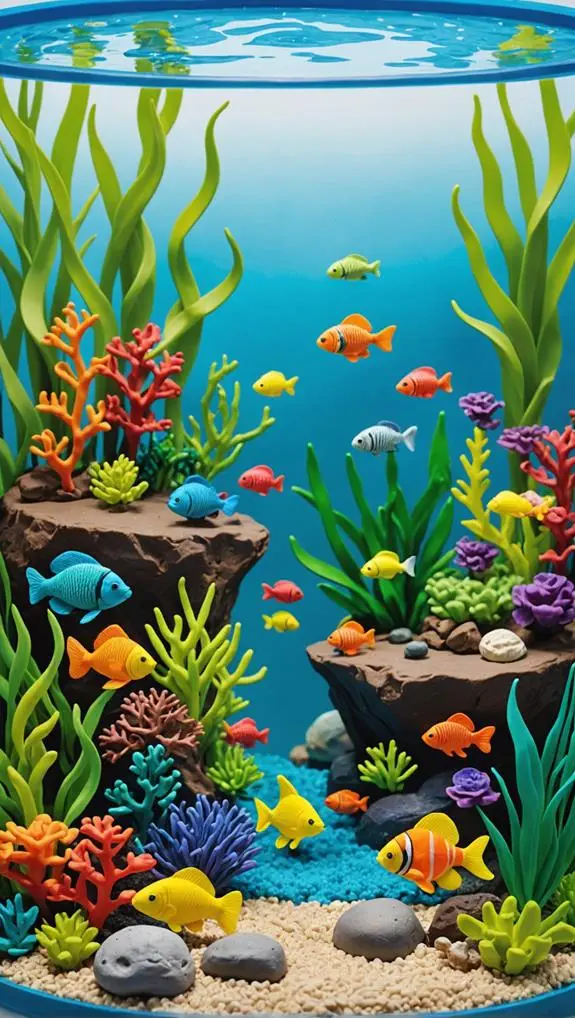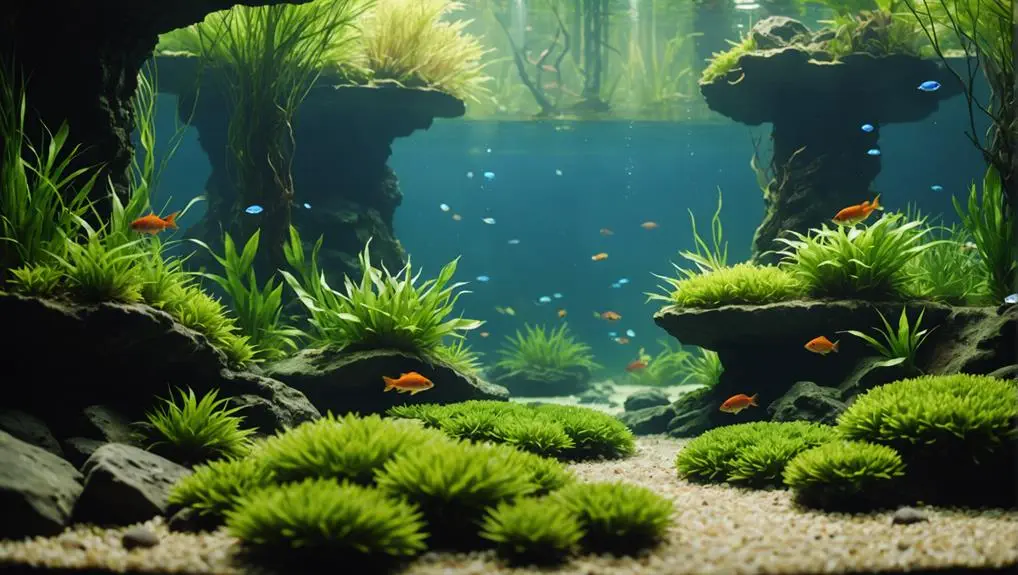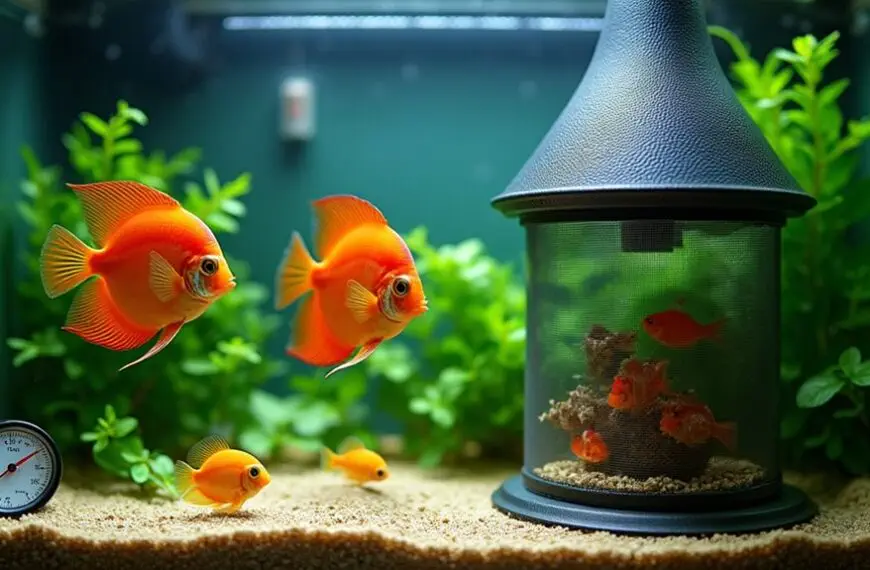Breeding freshwater fish can be a rewarding adventure! Start by setting up a separate breeding tank with good water quality, maintaining a cozy temperature between 78-82°F. Pick vibrant, healthy fish for breeding—color is key! Regular water testing is crucial, and don't skimp on cleanings. When those little fry arrive, feed them tiny meals several times a day using crushed flakes or live food for healthy growth. Keep an eye out for common issues like fin rot, too. With a bit of patience and love, you'll be on your way to creating a bustling underwater family! Curious about more specifics?
Contents
Understanding Breeding Conditions
When you're ready to breed freshwater fish, understanding the right conditions is crucial. You want to create an environment that mimics spring, when these fish naturally thrive.
Start by setting up a separate breeding tank, where you can control water quality and parameters. Keep an eye on pH, hardness, and alkalinity, aiming for that sweet spot—typically between 78-82°F.
Providing a suitable environment is essential for the health of your fish, so consider adding live plants to improve oxygen levels and aesthetics, as they can greatly benefit the breeding process benefits of live plants.
Temperature adjustments can help trigger spawning, so don't hesitate to tweak things a bit.
Once you've got the tank ready, it's time to think about the fish to breed. Select vibrant, healthy pairs that are mature and eager to mate.
Conditioning them with high-protein foods, like brine shrimp or bloodworms, can make a world of difference. Feed them three times a day to boost their readiness.
With the right conditions in place, you'll create a cozy, safe space for your tropical fish to spawn.
Just remember, patience is key. Sometimes, they might take their sweet time to get in the mood. So, sit back, enjoy the journey, and let nature do its thing!
Selecting Healthy Breeding Pairs
When you're on the hunt for healthy breeding pairs, keep an eye out for fish that flaunt vibrant colors and show off their size and vigor. These traits not only signal good health but also hint at their readiness to spawn, which is exactly what you want.
Additionally, ensuring the fish are from a suitable tank size can promote their overall well-being and reduce stress during the breeding process, as tank setup and size considerations play a significant role in fish health.
Plus, choosing fish from reputable sources will help ensure you're not bringing home any hidden genetic surprises—no one wants a surprise party when all they wanted was a peaceful breeding tank!
Vibrant Color Indicators
Selecting healthy breeding pairs is crucial for successful freshwater fish reproduction, and vibrant coloration serves as a key indicator of overall health and vitality.
When you're on the lookout for breeding pairs, keep an eye out for those bright, eye-catching colors. Healthy fish often show vibrant coloration, signaling their readiness to reproduce. Look for consistency in their color patterns that match their specific fish species; this not only indicates good health but also helps maintain genetic quality in future generations.
Watch how they behave, too! Active swimming and social interactions typically show that these potential breeders are in good shape. It's like their way of saying, "Hey, I'm ready to make some baby fish!"
Don't forget about age—young, vibrant fish usually have higher spawning success rates.
Size and Vigor Factors
Choosing the right size and vigor in breeding pairs is essential for successful freshwater fish reproduction. When you're looking for your breeding pairs, pay close attention to their overall health and activity levels. Fish that are vibrant and swim actively often indicate good health and reproductive readiness.
Here are some tips to help you select the best breeding pairs:
- Look for vibrant colors: Brightly colored fish generally indicate good health.
- Check their size: Ensure they're optimal for their species, as size matters in breeding.
- Observe their vigor: Active, strong swimmers are more likely to be successful breeders.
- Consider genetic diversity: Mixing different genetic backgrounds helps reduce health issues for future fry.
Aim to choose mature specimens, especially when you're shopping in late winter or early spring. This timing aligns with their natural spawning season, increasing your chances of successful breeding.
Always inspect for any signs of health problems, like fin rot or lumps, because healthy fish produce healthier offspring. By focusing on size and vigor, you're not just setting up for spawning; you're nurturing future generations of beautiful freshwater fish!
Maintaining Water Quality

Maintaining water quality is crucial for the successful breeding of freshwater fish. You want to keep your aquatic friends happy and healthy, especially during spawning.
Start by regularly testing your water parameters, like ammonia levels, nitrate, nitrite, pH, and hardness. Each fish species has its own ideal ranges, so be sure to know what works best for yours. Consistent temperatures and stable pH levels are essential for preventing stress and ensuring a successful breeding environment, as proper water parameters directly impact fish health.
Don't forget to perform partial water changes of 20-30% every week. This keeps toxins at bay and maintains optimal water quality. Introducing beneficial bacteria through substrate or filter media can help with biofiltration, breaking down waste effectively.
Using sponge filters is a great idea too! They promote aeration without risking injury to fry, creating a gentle flow that helps everyone thrive.
Just keep an eye on algae growth; controlling nutrient levels is essential to prevent it from spiraling out of control.
Feeding Techniques for Fry
Once you've established a stable environment for your fish, it's time to focus on feeding techniques for fry. These little swimmers need special care to thrive, and your attention can make all the difference.
Newly hatched fry depend on their yolk sacs for nutrition initially, so introducing infusoria or specialized fry food within the first week is crucial.
As they grow, you can begin to feed the fry finely crushed flakes or micro-pellets. Eventually, you'll want to include tasty treats like baby brine shrimp to meet their growing needs.
To keep those tiny bellies full and happy, aim to feed them at least six times a day in small portions.
Here are some helpful tips:
- Use eyedroppers or basters for precise feeding
- Monitor fry behavior for active feeding patterns
- Maintain excellent water conditions to avoid stress
- Adjust food sizes as they grow
Common Health Issues

When it comes to keeping your freshwater fish healthy, spotting symptoms early can make a world of difference.
You wouldn't want your fish to feel like they're in a spa gone wrong, right?
Recognizing Symptoms Early
Recognizing symptoms early is crucial for keeping your freshwater fish healthy and thriving. In the beautiful world of breeding egg-laying fish, it's essential to pay attention to any changes in your aquatic friends.
Regular observations can make all the difference in their good health. Here are some common symptoms to look out for:
- Fin Rot: Look for frayed fins, often a sign of poor water quality.
- Swim Bladder Disease: If your fish are having trouble staying afloat, overfeeding might be the culprit.
- Cotton Wool Disease: White, fluffy patches on your fish indicate a fungal infection that needs immediate attention.
- Gas Bubble Disease: If you see bubbles forming under your fish's skin, slow your water changes down!
Preventative Measures Implemented
Maintaining the health of your freshwater fish goes beyond just spotting symptoms; it also involves implementing effective preventative measures. By keeping a close eye on water quality, you can avoid issues like fin rot and swim bladder disease, which often stem from poor conditions. Regularly check ammonia, nitrate, and pH levels to keep your fish happy and healthy.
In your breeding tanks, a routine of partial water changes and substrate vacuuming is essential. This helps prevent fungal infections like cotton wool disease. Adding stress-reducing elements, such as hiding spots and compatible tank mates, can also lower the risk of lymphocystis viral infections caused by stress.
When you change the water, do it gradually to prevent gas bubble disease; sudden shifts in temperature can be quite shocking for our finned friends.
Additionally, be mindful of what and how often fish are fed. A controlled diet, with meals lasting about 2-3 minutes, helps avoid overeating and keeps swim bladder issues at bay.
Choosing the Right Species
Choosing the right species for breeding can significantly impact your success as an aquarist. If you're just starting, livebearers like guppies and mollies are fantastic options. They're easy to care for and produce live fry, making them a great choice for beginners.
On the other hand, egg-laying species such as tetras and corydoras require a bit more finesse. They thrive in stable water conditions, so if you're ready to dive deeper, they could be a rewarding challenge.
Here are some tips to consider when choosing species of fish:
- Start with livebearers for a simpler experience.
- Explore egg-laying species if you want to develop your skills.
- Research water conditions specific to each fish to ensure success.
- Select vibrant colors and strong genetics to enhance your breeding output.
Practical Tips for Small Aquariums

When you're working with small aquariums, creating an ideal environment for breeding can be both rewarding and challenging. Start by setting up a separate breeding tank, ideally at least 10-20 gallons, to easily control water parameters. This helps minimize stress for your breeding pairs, which is crucial for their success.
Use spawning mops or fine-leaved plants as breeding surfaces; they not only provide cover for eggs but also make it easier for fry to grow in tight spaces.
Don't forget to monitor the temperature and adjust it slightly to between 78-82°F to encourage breeding behaviors in species like guppies and tetras.
Frequent water changes are vital too—aim for at least 20% weekly to keep the water quality pristine. Small aquariums can quickly swing in ammonia and nitrate levels, so staying on top of this is key.
Lastly, feed your breeding pairs a high-protein diet, like live or frozen foods, to condition them for spawning and ensure they produce healthy fry.
With these tips, you'll be well on your way to creating a thriving breeding environment!
Frequently Asked Questions
How to Encourage Fish to Breed?
To encourage fish to breed, adjust temperature control, improve water quality, and set up a suitable tank. Use feeding strategies, create hiding spots, and observe breeding pairs under proper lighting to stimulate spawning conditions.
What Are the Breeding Strategies of Fish?
Curious about fish breeding strategies? You'll uncover fascinating spawning behaviors, parental care practices, and mating rituals. Nest building, territorial instincts, and environmental factors all influence fry development and genetic diversity throughout their breeding cycles.
What Freshwater Fish Are Easiest to Breed?
If you're looking for easy freshwater fish to breed, consider guppies for rapid fry production, tetras for mating fun, or corydoras for charming pairings. Platies and mollies also offer delightful breeding experiences for you!
What Helps Fish Reproduce?
If you think breeding fish is too complicated, you'll find it rewarding! Focus on a comfortable breeding environment, maintain excellent water quality, control temperature, meet dietary needs, and design a tank with plants for stress reduction.
Final Thoughts
Breeding freshwater fish can seem tricky, but it's totally doable with the right tips! You might worry about not having enough space or experience, but even a small aquarium can be a thriving breeding ground. Just remember to keep the water clean, choose healthy pairs, and be patient with the fry. With a little love and care, you'll see your fish flourish. So dive in and enjoy the rewarding journey of fish breeding—it's a splash of fun!












